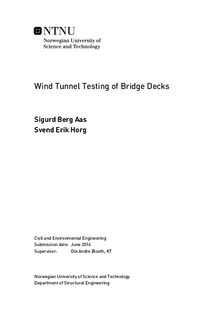Wind Tunnel Testing of Bridge Decks
Abstract
The studies done in this thesis was connected to an early stage implementation ofa new test method for ?nding aerodynamic properties of bridge deck sections at theNorwegian University of Science and Technology (NTNU), Department of StructuralEngineering. This method is based on wind tunnel measurements of cross sectionsusing a forced vibration principle where the bridge motion is forced by a custommade test rig. The rig performing the forced vibration tests is the ?rst of its kindat NTNU, and can produce motion in three degrees of freedom (horizontal, verticaland rotational), both separately and simultaneously. The forced vibration method isgaining popularity as it introduces a variety of possibilities in terms of aerodynamictesting.
The main goal of these studies was to develop a process of building bridge sectionmodels compatible with the forced vibration test rig and suited for early stage testingof cross section design. Furthermore, it was an objective to do wind tunnel testingof the crafted section models, and to analyze the output from the testing in terms ofdata quality and aerodynamic properties.The objectives were pursued in a four stage process. Theory studies and a series ofcalculations and material tests led to the design of two bridge sections strong and sti?enough to withstand the wind tunnel loading. The building process was performedat the department lab where all the design solutions were implemented. A series offorced vibration test were performed in the wind tunnel at NTNU, Department ofEnergy and Process Engineering (EPT), and the outputs from the tests were postprocessed and analyzed.
The work done resulted in a procedure of building models using the equipmentavailable at the department and the materials found suitable. This includes a com-prehensive study of the individual material properties as well as the properties ofthe model as a whole. The possible designs of choice were thoroughly assessed, andthis led to a choice of two section model concepts. A rectangular shaped sectionserved as a reference model which was easy to build, while a Twin section becamethe main model of interest in this thesis. Aerodynamic properties of the models wereextracted from data obtained by wind tunnel testing, and a quality assessment con-cerning the performance of the model was completed. Further, a comparing study ofthe results from the Twin section was performed with a similar bridge concept calledBrusymfonien.
The section models developed in this thesis were found compatible with the forcedvibration rig for the purpose of extracting aerodynamic properties. However, furtherwork is required to increase the accuracy and achieve more stable results. Mostimportant in this matter was shown to be the overall sti?ness of the models
